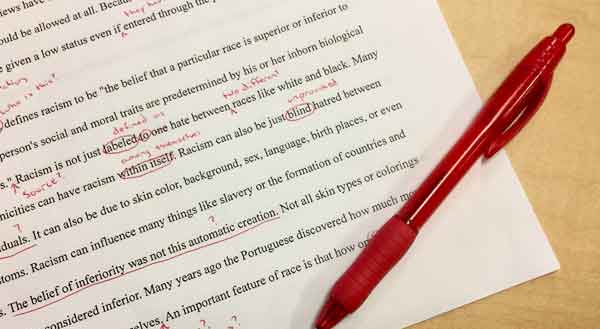Nonfiction Book Editors Near Me

Before you begin your search for book editors near you, it would be useful to clarify the different stages of editing that will come into play in your nonfiction book.
There’s a lot of confusion in self-publishing circles about the different roles that editors play, and this confusion gets compounded by the fact that sometimes the same editor may perform multiple roles.
So, to clear the air, I’ll describe below what the different editing stages are and why each one is necessary in order to create a high-quality nonfiction nook.
What Are the Different Types of Book Editors?
There are four distinct editing stages required to produce a top-notch nonfiction book, beginning with the 30,000-foot view of your overall book structure and ending on the ground dealing with the minutiae of checking for missing punctuation marks.
Each stage will play a critical role in the transformation of your writing from a first draft manuscript to a premium quality book that will be consistently reviewed with praise and thoroughly enjoyed by your readers.
Here are the four editing stages in order or priority:
1- Developmental Book Editing
The first type of editing that your nonfiction book will require is developmental book editing.
In this stage your editor will look at the overall book structure (the 30,000-foot view) in order to assess if it’s adequate to support your main thesis.
Then, they’ll determine whether your flow of ideas, thoughts and concepts is laid out in the best possible way to address the needs of your target audience.
They’ll show you what works from the standpoint of your readers and then they’ll show you what doesn’t work and give you suggestions to fix it.
As the author, you’re simply too close to your book to be able to have an unbiased opinion, and the developmental editor will help you gain the necessary perspective so that you can “see the forest for the trees” and make objective decisions.
Don’t look at the developmental editor so much as a critic but as a coach who will lay out the overall strategy you need to follow for your book to achieve its potential.
There are two mechanisms that they’ll use to share their thoughts with you:
The Developmental Book Editor’s Letter
The developmental editor’s letter will tackle the biggest structural issues in the book and make suggestions so that you can take the necessary corrective action.
This action might entail re-writing certain chapters, swapping them around, writing new ones and even eliminating unnecessary sections of the book that don’t support your thesis and don’t add any value to your readers.
Once you’ve completed this major initial revision, your manuscript will have a much more solid foundation, strong enough to begin the second phase of developmental editing: page-by-page commenting.
Page-By-Page Comments
Here, your developmental editor will go through every page of your manuscript and write notes in the margin using the track-changes feature in your word processor.
These notes won’t be related to spelling, grammar and punctuation errors but to the actual content of the text.
For instance, they may point out that a particular sentence is out of place and should be moved elsewhere, of that a paragraph contains too many ideas and should be broken up.
Once your developmental editor’s job is done, it’s time to begin the next editorial stage for your book.
2- Content Book Editing

If developmental editing is about structure, content book editing is about mechanics.
Now that the flow of ideas in your book is well established, it’s time to move on to the execution of those ideas. Your content editor will switch focus to readability, making suggestions to improve the clarity of your message.
For example, they’ll identify run-on sentences, misuse of words, overuse of words, repetition of words in close proximity, poor writing style, and so on.
They’ll also suggest the best placement for images, charts, diagrams, etc. in relation to your text in order to best support your ideas.
Once the content editing stage is completed, it’s time to perform copy editing.
3- Copy Editing
The copy editor won’t focus on book structure or mechanics, but instead on language accuracy. Their main goal is to ensure that there are no spelling, punctuation, grammatical or syntax errors.
As part of the copy-editing pass, they’ll also look for consistency in the use of capitalization rules, the correct use of hyphens, the correct use of numerals, etc.
If necessary, they will identify any factually inaccurate statements that need to be corrected by the author and point out inconsistencies in your text, for example if you’re referring to the same journal article in two parts of your book, but quoting two different journal issues.
In short, copy editors specialize in the application of accepted rules of style in the English language in order to create consistency for readers (for example, the vast majority of copy editors in the U.S. follow the Chicago Manual of Style or the Associated Press Style book).
4- Proofreading

The final book editing stage, applied when there are no more changes to be made in the manuscript, is proofreading. This is the stage implemented when your book is complete and ready to go to print.
Before committing your hard work to the permanency of printing, publishing and distribution, you need to make sure that all the T’s in your manuscript are crossed and all the I’s are dotted.
In other words, you want to be certain that your nonfiction book is devoid of errors, omissions, typos and inaccuracies.
This is precisely the job of the proofreader. They’ll make sure that your book is free from:
- Punctuation, spelling, grammatical and syntax errors
- Formatting inconsistencies
- Incorrect references
- Inaccurate facts and figures
- Erroneous captions
Unlike most of us, proofreaders have the uncanny ability to laser focus on the language without getting distracted by the art.
In other words, the reason we don’t see as many typos as they do (at least the not-so-obvious ones) is that since we’re so focused on the narrative of the story, our brains will happily skip these minor speed bumps for the sake of our reading enjoyment.
Once the proofreading stage is completed, your book is ready to go to the printer!
Next Steps
Sometimes different book editors will specialize in each stage, occasionally you may find a super-editor that can do it all, and sometimes you’ll find book editors that are experienced in two of the stages.
So, be prepared to hire multiple editors, keeping in mind that the total editing cost may not change that much with fewer editors because all stages still need to be implemented for your nonfiction book to be the best that it can.
Good luck in your search!
If you enjoyed this article and are in the process of writing a nonfiction book, be sure to check out my free nonfiction success guide, drawn from years of experience editing books for bestselling authors (including a New York Times bestseller) and ghostwriting for CEOs and politicians. Simply click here to get instant access.
Ben
Leave me a comment below if you have any questions or a specific need that I can help you address – I operate an author services firm that specializes in helping entrepreneurs, professionals and business owners who want to publish books as a calling card for prospects, to establish their status as an expert or to just to generate additional leads for their businesses.
Here are some related posts I highly recommend:
How to Grow Your Business Writing a Nonfiction Book
Learn 10 Powerful Writing Habits to Fast Track Your Nonfiction Book
How to Find the Perfect Writing Coach for Your Nonfiction Book

Bennett R. Coles is an award-winning author of six books published through Harper Collins (New York) and Titan Publishing Group (London). He is also the publisher at Promontory Press, editor for multiple bestselling authors (including a NY Times bestseller), ghostwriter for CEOs and politicians and the founder of Cascadia Author Services, a boutique full-service firm that specializes in premium author services specifically designed for busy professionals. Our end-to-end services include writer coaching, ghostwriting, editing, proofing, cover design, book layout, eBook production, marketing, printing and distribution.







Leave a Reply